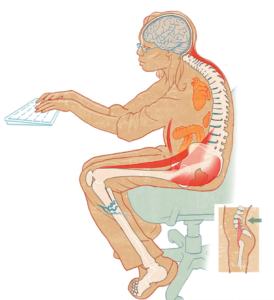Ecomeny & Contactless Delivery
Ecomeny & Contactless Delivery

One of the most obvious symptoms of the sitting disease in the eyes of physical therapists and other healthcare practitioners is often left completely off the list, and that symptom is “disuse atrophy.” Simply put, disuse atrophy is when a muscle shrinks due to inactivity.

Our bodies are meant to move throughout the day, and prolonged inactivity will cause muscle groups to deteriorate and lose mass. If you’ve ever had a cast for more than a couple weeks, you may remember how difficult it was to use your arm or leg when you first removed the cast. Disuse atrophy is a nightmare for professional athletes recovering from an injury, and for astronauts spending months in zero gravity. But disuse atrophy also affects regular office workers, particularly those who sit for hours at a time.
When you walk, and even when you stand, your spine is supported by your abdominal and back muscles. But according to an article by Holistic Nutritionist Michelle Dawn, sitting for too long will affect your abs and back muscles, particularly your erector spine muscles, which run parallel along your spine. These muscles are essential for stabilizing your back, and their deterioration can lead to permanent damage to your spinal structures and cause back pain.
It doesn’t get better below the waist, either. The below info-graphic highlights many of the ways sitting harms our bodies, and what is most clear is that the problems don’t end with the back and abs. Some of the worst disuse atrophy occurs in the hip flexors and the glutes, which govern your range of motion and give you the power to push off from your seat.
Atrophy in these muscle groups result in weak, inflexible hips and a shorter stride. Prolonged sitting can also cause atrophy in your glutes. Weak glute muscles can also lead to hip bursitis, in which your hip bursa—fluid sacs that act as a lubricant between tissues in your hips—become painfully swollen. All of this deterioration happens every day to unsuspecting office workers.
The Solution to the Sitting Disease Is Simple
The best way to combat sitting disease is simply to get out of your seat! Regardless of your seat choice, the majority of practitioners will echo the same advice to ensure greater mobility and to ultimately reduce the effects of a sedentary lifestyle.
If we look at the past couple of years we have seen a greater awareness with technology devices such as Fitbit's or the Apple Watch including multiple health tracking apps and features which help promote a healthier lifestyle. Nothing beats a little reminder from your watch to get up and move! This surge in technology to promote health alongside a greater understanding in science and general health is leading the way for a healthier lifestyle.
In addition to this being aware of what components make a great chair can greatly assist with reducing pressure upon your body while working the traditional 40 hour week. Everyone has different specifications for their chair, as individuals we are wonderfully unique, and at BestOffice all our collections are based on promoting health, support and comfort. If you liked this blog post leave a comment or give us a follow on social media.
Thanks
{"one"=>"Select 2 or 3 items to compare", "other"=>"{{ count }} of 3 items selected"}
Leave a comment